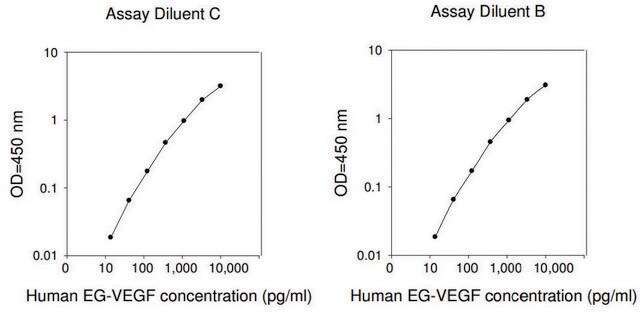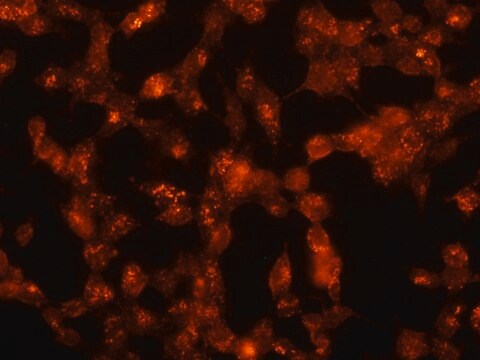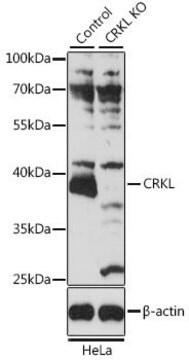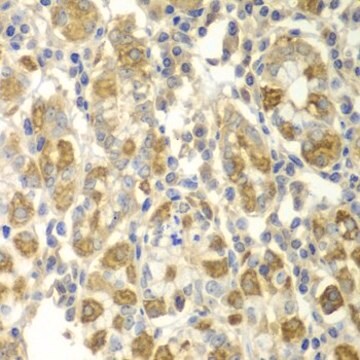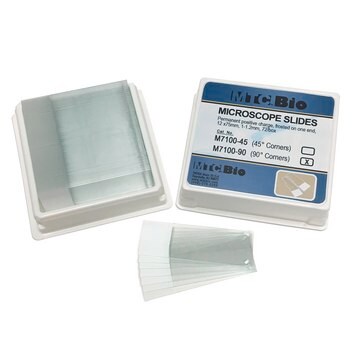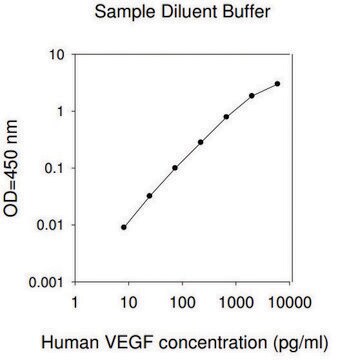V6137
VEGF Receptor-1 (Flt-1)/Fc Chimera from mouse
≥90% (SDS-PAGE), recombinant, expressed in NSO cells, lyophilized powder, suitable for cell culture
Sinónimos:
Vascular Endothelial Growth Factor Receptor‑1
Iniciar sesiónpara Ver la Fijación de precios por contrato y de la organización
About This Item
Productos recomendados
biological source
mouse
Quality Level
recombinant
expressed in NSO cells
assay
≥90% (SDS-PAGE)
form
lyophilized powder
potency
10-30 ng/mL ED50
mol wt
calculated mol wt ~110 kDa
packaging
pkg of 100 μg
storage condition
avoid repeated freeze/thaw cycles
technique(s)
cell culture | mammalian: suitable
impurities
endotoxin, tested
UniProt accession no.
storage temp.
−20°C
Gene Information
mouse ... Flt1(14254)
Application
VEGF Receptor-1 (Flt-1)/Fc Chimera from mouse was used for investigating the vascular potential of hematopoietic stem cells. It may be used to study vasculogenesis and angiogenesis.
Biochem/physiol Actions
VEGF Receptor-1 (VEGF R1) also known as Flt-1 belongs to class III subfamily of RTKs and expresses mainly in endothelial cells. VEGF R1 binds to vascular endothelial growth factor B (VEGF-B) and hence facilitates in regulating the plasminogen activator activity in endothelial cells.It also assists endothelial cells in the proper spatial organization of lumen-containing vessels. Additionally, alternatively spliced VEGF R1 pre-mRNA helps in regulating the VEGF activity in angiogenesis.
VEGF receptors, class III receptor tyrosine kinases, have seven Ig like extracellular motifs and a tyrosine kinase intracellular domain split by a kinase insert sequence. VEGFR 1 was originally called fms like tyrosine kinase 1 (flt 1), indicating its homology to receptors of PDGF, M CSF, and SCF. VEGFR 1 is one of the five receptor tyrosine kinases (KDR/Flk-1, Flt-4, tie-1 and tek/tie-2) whose expression is almost exclusively restricted to endothelial cells. These receptors are likely to play central roles in vasculogenesis and angiogenesis. Recombinant VEGF R1 binds VEGF with high affinity and is a potent VEGF inhibitor. VEGFR 1 and 2 are both expressed in an endothelial cell-specific manner and are detectable in virtually all tissues in adults and embryos. Hypoxia induces endothelial cell expression of VEGFR 1 but not VEGFR 2. Monocytes express VEGFR 1 and 2 and can migrate to the site of VEGF release, but this response appears to be VEGFR 1 mediated. VEGFR 2 is also expressed in pancreatic duct cells. VEGFR 2 is involved in commitment of endothelial-cell lineages and to cell proliferation, while VEGFR 1 seems to be responsible for guiding endothelial cells into the proper spatial organization into lumen-containing vessels. VEGFR 2 is a key marker for pluripotent HSCs. Neurophilins, a group of unrelated receptors for some VEGF family members may also act as coreceptors to facilitate VEGF binding to VEGFR 2. VEGFR 3 is a specific marker for lymphatic vessels. VEGFR 3 has also been detected on some high endothelial venules, in embryonic pre-lymphatic blood vessels, some tumor blood vessels, and certain hematopoietic and leukemia cells.
Physical form
Lyophilized from a 0.2 μm filitered solution in 20 mM MOPS, 500 mM NaCl and 0.05% CHAPS
Analysis Note
The biological activity is measured by its ability to inhibit VEGF-dependent proliferation of human umbilical vein endothelial cells.
Storage Class
11 - Combustible Solids
wgk_germany
WGK 1
flash_point_f
Not applicable
flash_point_c
Not applicable
Elija entre una de las versiones más recientes:
¿Ya tiene este producto?
Encuentre la documentación para los productos que ha comprado recientemente en la Biblioteca de documentos.
Steven M Guthrie et al.
Methods in molecular medicine, 105, 369-380 (2004-10-20)
The hematopoietic stem cells residing in the bone marrow have tremendous proliferative and self-renewing capacity, and until recently these cells were thought to produce only progeny of the blood lineages. We have recently demonstrated that these cells are capable of
Y He et al.
Molecular endocrinology (Baltimore, Md.), 13(4), 537-545 (1999-04-09)
Angiogenesis is essential for normal mammalian development and is controlled by the local balance of pro- and antiangiogenic factors. Here we describe a novel mouse cDNA sequence encoding sFLT-1 that is a potent antagonist to vascular endothelial growth factor (VEGF)
B Olofsson et al.
Proceedings of the National Academy of Sciences of the United States of America, 95(20), 11709-11714 (1998-09-30)
The vascular endothelial growth factor (VEGF) family has recently expanded by the identification and cloning of three additional members, namely VEGF-B, VEGF-C, and VEGF-D. In this study we demonstrate that VEGF-B binds selectively to VEGF receptor-1/Flt-1. This binding can be
Nuestro equipo de científicos tiene experiencia en todas las áreas de investigación: Ciencias de la vida, Ciencia de los materiales, Síntesis química, Cromatografía, Analítica y muchas otras.
Póngase en contacto con el Servicio técnico